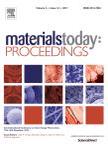版权所有:内蒙古大学图书馆 技术提供:维普资讯• 智图
内蒙古自治区呼和浩特市赛罕区大学西街235号 邮编: 010021

作者机构:Centre of Excellence in Particle and Material Processing Technology Department of Chemical Engineering Faculty of Engineering Chulalongkorn University Bangkok 10330 Thailand Department of Materials Engineering Faculty of Engineering Kasetsart University Bangkok 10900 Thailand National Nanotechnology Center (NANOTEC) National Science and Technology Development Agency (NSTDA) Pathumthani 12120 Thailand
出 版 物:《Materials Today: Proceedings》
年 卷 期:2020年第23卷
页 面:720-725页
学科分类:08[工学] 0805[工学-材料科学与工程(可授工学、理学学位)] 080502[工学-材料学]
主 题:Solar selective absorber Convective deposition Cermet Ni nanoparticle-Al 2 O 3
摘 要:Nowadays nanostructured materials have become widely used in applications of concentrating solar power (CSP) system. Solar absorber, one of the most important layers in a multilayer solar selective coating, is used to convert solar energy into heat due to its selective properties. Recently, Ni nanoparticle solar absorbers have attracted considerable attention because they offer maximized absorption and minimized thermal radiation loss. However, only few detailed investigations on the effects of morphology and structure of Ni nanoparticle on the selective absorber properties have been reported. Therefore, in this work we synthesized Ni nanoparticles via a chemical reduction method. The rapid convective deposition was used to fabricate Ni nanoparticle-Al 2 O 3 cermet thin film as the solar selective absorber. The various ratios of [NaOH]/[NiCl 2 ] ranging from 4-20 was investigated in order to study the effects on the morphology of Ni nanoparticles. Characterization of the morphology and structure of Ni nanoparticles and cermet thin film was performed using scanning electron microscopy (SEM) and X-ray diffraction (XRD), respectively. Emissometer was used to measure the thermal emittance, and UV-Vis-NIR spectrophotometer was used to measure the reflectance of the film. It was found that the formation of chain-like nanostructure of Ni appeared when the molar ratio of [NaOH]/[NiCl 2 ] was 4. Increasing molar ratios resulted in longer chain formation. However, when the molar ratio reached 20, spherical-like Ni nanoparticles were observed. Moreover, at this ratio, Ni nanoparticle-Al 2 O 3 cermet film demonstrated a solar absorptance of 0.64 and a thermal emittance of 0.53, resulting in a solar selectivity of 1.20 which is suitable as solar selective absorbing coating applications.